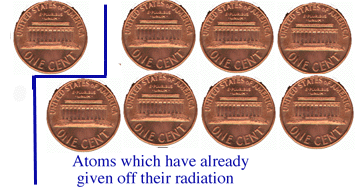Half lives
There is always a 50% chance in a given time that an atom will give off it's radiation. This time is called a half life.
To help understand what a half life is we will go through an imaginary example. Lets pretend that a penny is a radioactive element.
| If the head of the penny is up it is radioactive. |  |
| If the head of the penny is down it has already given off its nuclear radiation. |  |
If I flip a penny with it's head up, I have a fifty percent chance of it coming up tails meaning it will give off it's radiation.
| Here is an example with 8 pennies. At the start, all pennies have their heads up. |
 |
| After 1 flip (1 half life) 4 pennies come up tails which means they have given off their radiation. |
 |
After the first flip there are only 4 pennies left that still are radioactive. I will put the tails to the side and flip only the heads.
| After the second flip, (2nd half life), 2 more of the remaining pennies come with tails up. This means only two pennies are left which have not given off their radiation. |
 |
| After one more flip (one more half life) only one penny is left heads up meaning only one penny still has not given off it's radiation. |
 |
| After the fourth flip, the last penny come up tails which means all of the pennies have given off their radiation. |
 |
Notice that after each flip half of the pennies that were flipped came up tails. In our little example that means that after each half life (flip) half of the radioactive atoms gave off their radiation (came up tails)
Click here to go through a real example of radioactive half lives







